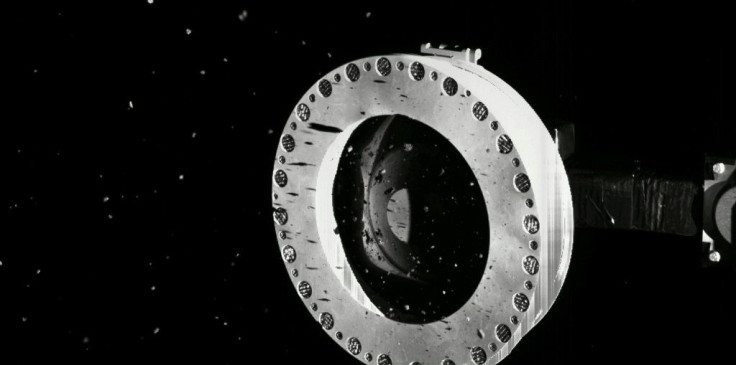OSIRIS-REx Mission: NASA Expedites Stowing Of Asteroid Samples Leaking From Spacecraft
KEY POINTS
- Asteroid samples captured by the OSIRIS-REx spacecraft appear to be leaking
- NASA is now expediting the stowage process to protect the samples
- Instead of Nov. 2, the process will be performed on Tuesday
NASA's Touch-And-Go (TAG) event was so successful that the spacecraft appeared to be "overflowing" with asteroid samples. To protect the precious samples, the agency decided to expedite the mission and stow the samples a week ahead of schedule.
It was just days after the historic Oct. 22 event when NASA confirmed that the OSIRIS-REx spacecraft met its goal of collecting at least 2 ounces (60 grams) of sample from asteroid Bennu, collecting "more than enough" of the material. However, the mission was so successful that the asteroid particles appeared to be "leaking" from the spacecraft.
Images of the Touch-And-Go Sample Acquisition Mechanism (TAGSAM) revealed that the collected particles were actually slowly escaping from the spacecraft, likely because larger particles may have kept TAGSAM's mylar flap open, thereby allowing the smaller particles to escape.
Originally, the plan was to stow the sample in the spacecraft's Sample Return Capsule (SRC) on Nov. 2. But because the samples are slowly leaking from the spacecraft, NASA said in a news release that the procedure will be expedited and performed starting Tuesday to prevent losing more of the samples.
OSIRIS-REx will perform the task in stages instead of autonomously, with each stage being closely monitored by the mission team, NASA explained. For each step, the team will send the commands for the spacecraft to follow, after which it will be the spacecraft’s turn to send back data and images to the team.
As the agency explained in the news release, each step will likely take about 37 minutes of communications since one way signals take 18.5 minutes to travel from the Earth to the spacecraft and vice versa.
All in all, the entire stowage process could take several days.
"One week ahead of schedule [and] exceeding all expectations, our OSIRIS-REx spacecraft is ready to stow its samples collected from asteroid Bennu!" NASA said in a tweet.
One week ahead of schedule & exceeding all expectations, our @OSIRISREx spacecraft is ready to stow its samples collected from asteroid Bennu!
— NASA (@NASA) October 26, 2020
Read more about the latest mission developments #ToBennuAndBack: https://t.co/GFjKADhuaT pic.twitter.com/ciTXUD73Kj
The goal is to protect as much of the asteroid Bennu samples as possible. Once safely stowed, the samples will then be ready for the journey back to Earth, where OSIRIS-REx is expected to arrive by 2023.
"The abundance of material we collected from Bennu made it possible to expedite our decision to stow," OSIRIS-REx principal investigator at the University of Arizona, Dante Lauretta, said in the NASA news release. "The team is now working around the clock to accelerate the stowage timeline, so that we can protect as much of this material as possible for return to Earth."

© Copyright IBTimes 2025. All rights reserved.






















